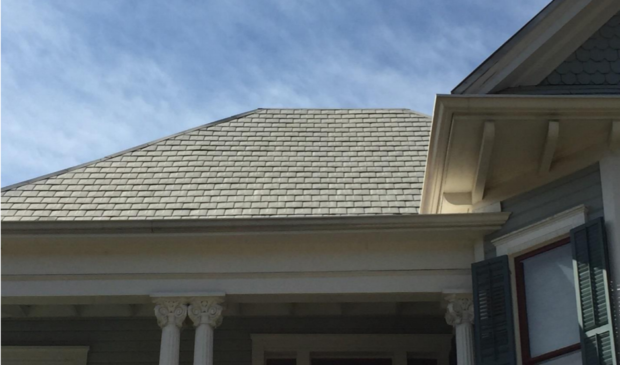Which shingles are the right shingles on a historic structure?
Thursday, February 28, 2019 by
Jessi Devenyns Roofs are pesky. Every 25 years or so they need to be replaced, though not usually with an identical material. Over a quarter-century, technology advances, materials become more environmentally friendly, and roof materials can easily affect a home’s energy efficiency. That means historic homes are often left searching for outdated materials or options that mimic roof coverings from over 100 years ago.
Mark Mueller, the owner of 705 San Antonio St., was faced with this predicament at the Feb. 25 meeting of the Historic Landmark Commission. His historic home has a leaky asphalt shingle roof that he wishes to replace with standing seam metal. He presented his argument to the commission, citing the material’s longevity, energy efficiency and environmental sustainability.
The commissioners, however, were not swayed. “We’re concerned more about appearance than material,” explained Commissioner Kevin Koch. He noted that this case had previously been reviewed in the Certificate of Appropriateness Committee where the homeowner received the suggestion of installing metal shingles and painting them to look like wood.
Commissioners explained that their adamance on the matter was not entirely their own. Since the structure is a recorded Texas historical landmark, the designation requires the home to be as close to original as possible. While Mueller needed to ask the Historic Landmark Commission for approval, Commissioner Kelly Little pointed out that additionally, “exterior changes need to be reviewed by the Texas Historical Commission.”
Mueller pointed out that 40 percent of the roof of the house was already metal and that most of the other historic homes in the area are crested with standing seam metal roofs. Therefore, he argued, permitting a change in the material of his home would allow him to fit better into the neighborhood character.
The state of other neighborhood homes, according to Commissioner Terri Myers, was “neither here nor there.” She insisted that for the sake of historical continuity, the visible parts of the roof must remain historically accurate.
In an effort to avoid a postponement of his case and to demonstrate the visual appeal of the commissioners’ proposed compromise of metal shingles, Mueller presented a few samples of the material. The commissioners were pleasantly surprised. “I wasn’t expecting metal shingles that look like wood,” said Little.
To get the ball rolling on Mueller’s efforts to repair his leaky roof, the commission unanimously passed a recommendation to allow standing seam on non-visible portions of the roof and a “more appropriate” material – to be determined by the Texas Historical Commission – on visible portions.
Commissioner Koch expressed that it was frustrating to “deal with a detail that is this important and this specific,” but added that “we do want the appearance to be correct.”
Photo courtesy of the city of Austin.
The Austin Monitor’s work is made possible by donations from the community. Though our reporting covers donors from time to time, we are careful to keep business and editorial efforts separate while maintaining transparency. A complete list of donors is available here, and our code of ethics is explained here.
You're a community leader
And we’re honored you look to us for serious, in-depth news. You know a strong community needs local and dedicated watchdog reporting. We’re here for you and that won’t change. Now will you take the powerful next step and support our nonprofit news organization?



